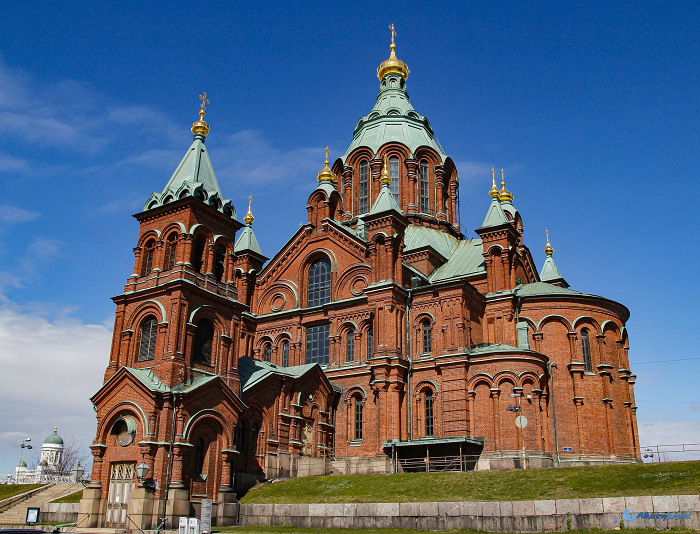The Uspenski Cathedral, locally known as Uspenskin katedraali and Uspenskijkatedralen, is an Eastern Orthodox cathedral that is nestled on a picturesque hilltop in the city of Helsinki, the capital of the Republic of Finland.

As this mesmerizing religious structure stands as a magnificent testament to the country’s rich cultural heritage, it is located more precisely on the Katajanokka Peninsula, dominating the skyline of Helsinki, and as it perches atop a rocky outcrop, the cathedral overlooks the bustling harbor, providing visitors with breathtaking panoramic views of the city and the Baltic Sea beyond.

With its striking redbrick exterior and golden onion domes glistening under the sun, Uspenski Cathedral exudes a captivating Eastern Orthodox allure, and the architectural style draws inspiration from the stunning Russian medieval churches, characterized by their ornate details, intricate frescoes, and elaborate mosaics.

The cathedral as inspired by these amazing structures nowadays with its soaring spires and arched windows makes it an imposing presence that commands the attention of the people and further invites them to do some exploration. As Uspenski was constructed between 1862 and 1868, it was designed by the Russian architect Aleksey Gornostayev, however, it was built after he died in 1862.

The cathedral was built on the site of an earlier wooden church, representing a fusion of Byzantine and Russian architectural influences, although it can be noted that the majority is Russian architectural influence. Interestingly, craftsmen from Russia and Finland joined forces in building this religious structure and did their best to bring Gornostayev’s vision to life, utilizing the redbrick that was imported from St. Petersburg.

In addition, the dedication ceremony took place on 25 May 1868, marking the completion of this remarkable spiritual masterpiece. The construction of the Uspenski Cathedral was initiated to meet the growing needs of Helsinki’s Russian Orthodox community during the Russian Empire’s rule over Finland, and as it was serving as the diocese for the Finnish Orthodox Church, the cathedral provided a sacred space for religious worship, ceremonies, and celebrations.

Its completion represented the affirmation of the Russian presence and cultural influence in Helsinki at the time. While the cathedral stands as a testament to Finnish history, it is not shrouded in mythical tales or legends, however, the cathedral’s grandeur and mystical ambiance have inspired countless stories and imaginations over the years.

Legend has it that during the construction, a humble Finnish laborer named Matti gained fame for his tireless dedication and skill, and as the superiors were impressed by his unwavering commitment, the architect commissioned Matti to carve a small wooden figure to be placed high above the entrance.

To this day, the little figure, known as “Matti’s Guardian,” watches over the cathedral, symbolizing the devotion and craftsmanship of the Finnish people.

Nowadays, as one of Helsinki’s most recognizable landmarks, Uspenski Cathedral serves as a cultural and historical touchstone, where beyond its religious significance, the cathedral stands as a cherished symbol of Finland’s heritage, inviting locals and tourists alike to explore its rich architectural beauty and soak in the serene atmosphere.

Additionally, it also serves as a reminder of the country’s multicultural past, offering a glimpse into the vibrant tapestry of Finnish history. In conclusion, with its commanding presence and captivating beauty, Uspenski Cathedral stands as a remarkable testament to Finland’s past, which allows visitors to delve into the rich tapestry of its history, experience the spirituality it embodies, and gain a deeper understanding of the cultural diversity that defines the nation today.




